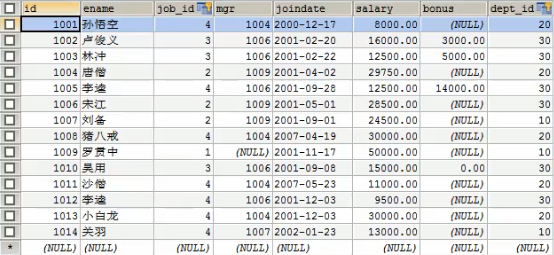概念
Spring 框架对 JDBC 的简单封装,提供了一个 JDBCTemplate 对象简化 JDBC 的开发。
步骤
1.导入 jar 包。
2.创建 JdbcTemplate 对象。依赖于数据源DataSource
1
| JdbcTemplate template = new JdbcTemplate(ds);
|
3.调用JdbcTemplate的方法来完成CRUD的操作。
- update():执行DML语句。增、删、改语句。
- queryForMap():查询结果将结果集封装为map集合,将列名作为key,将值作为value 将这条记录封装为一个map集合。
- queryForList():查询结果将结果集封装为list集合。
- 注意:将每一条记录封装为一个Map集合,再将Map集合装载到List集合中。
- query():查询结果,将结果封装为JavaBean对象。
- query的参数:RowMapper
- 一般使用BeanPropertyRowMapper实现类,可以完成数据到JavaBean的自动封装。
- new BeanPropertyRowMapper<类型>(类型.class)
- queryForObject:查询结果,将结果封装为对象。
4.示例
需求:
- 修改1号数据的 salary 为 10000。
- 添加一条记录。
- 删除刚才添加的记录。
- 查询id为1的记录,将其封装为Map集合。
- 查询所有记录,将其封装为List。
- 查询所有记录,将其封装为Emp对象的List集。
- 查询总记录数。
数据表:

代码:
1
2
|
private JdbcTemplate template = new JdbcTemplate(JDBCUtils.getDataSource());
|
1
2
3
4
5
6
7
8
|
public void test1(){
String sql = "update emp set salary = 10000 where id = 1001";
int count = template.update(sql);
System.out.println(count);
}
|
1
2
3
4
5
6
|
public void test2(){
String sql = "insert into emp(id,ename,dept_id) values(?,?,?)";
int count = template.update(sql, 1015, "郭靖", 10);
System.out.println(count);
}
|
1
2
3
4
5
6
|
public void test3(){
String sql = "delete from emp where id = ?";
int count = template.update(sql, 1015);
System.out.println(count);
}
|
1
2
3
4
5
6
7
8
|
public void test4(){
String sql = "select * from emp where id = ?";
Map<String, Object> map = template.queryForMap(sql, 1001);
System.out.println(map);
}
|
1
2
3
4
5
6
7
|
public void test5(){
String sql = "select * from emp";
List<Map<String, Object>> list = template.queryForList(sql);
for (Map<String, Object> stringObjectMap : list) System.out.println(stringObjectMap);
}
}
|
1
2
3
4
5
6
7
8
9
10
11
12
13
14
15
16
17
18
19
20
21
22
23
24
25
26
27
28
29
30
31
32
33
|
public void test6(){
String sql = "select * from emp";
List<Emp> list = template.query(sql, new RowMapper<Emp>() {
@Override
public Emp mapRow(ResultSet rs, int i) throws SQLException {
Emp emp = new Emp();
int id = rs.getInt("id");
String ename = rs.getString("ename");
int job_id = rs.getInt("job_id");
int mgr = rs.getInt("mgr");
Date joindate = rs.getDate("joindate");
double salary = rs.getDouble("salary");
double bonus = rs.getDouble("bonus");
int dept_id = rs.getInt("dept_id");
emp.setId(id);
emp.setEname(ename);
emp.setJob_id(job_id);
emp.setMgr(mgr);
emp.setJoindate(joindate);
emp.setSalary(salary);
emp.setBonus(bonus);
emp.setDept_id(dept_id);
return emp;
}
});
for (Emp emp : list) {
System.out.println(emp);
}
}
|
重点掌握
1
2
3
4
5
6
7
8
|
public void test6(){
String sql = "select * from emp";
List<Emp> list = template.query(sql, new BeanPropertyRowMapper<Emp>(Emp.class));
for (Emp emp : list) {
System.out.println(emp);
}
}
|
1
2
3
4
5
6
|
public void test7(){
String sql = "select count(id) from emp";
Long total = template.queryForObject(sql, Long.class);
System.out.println(total);
}
|
